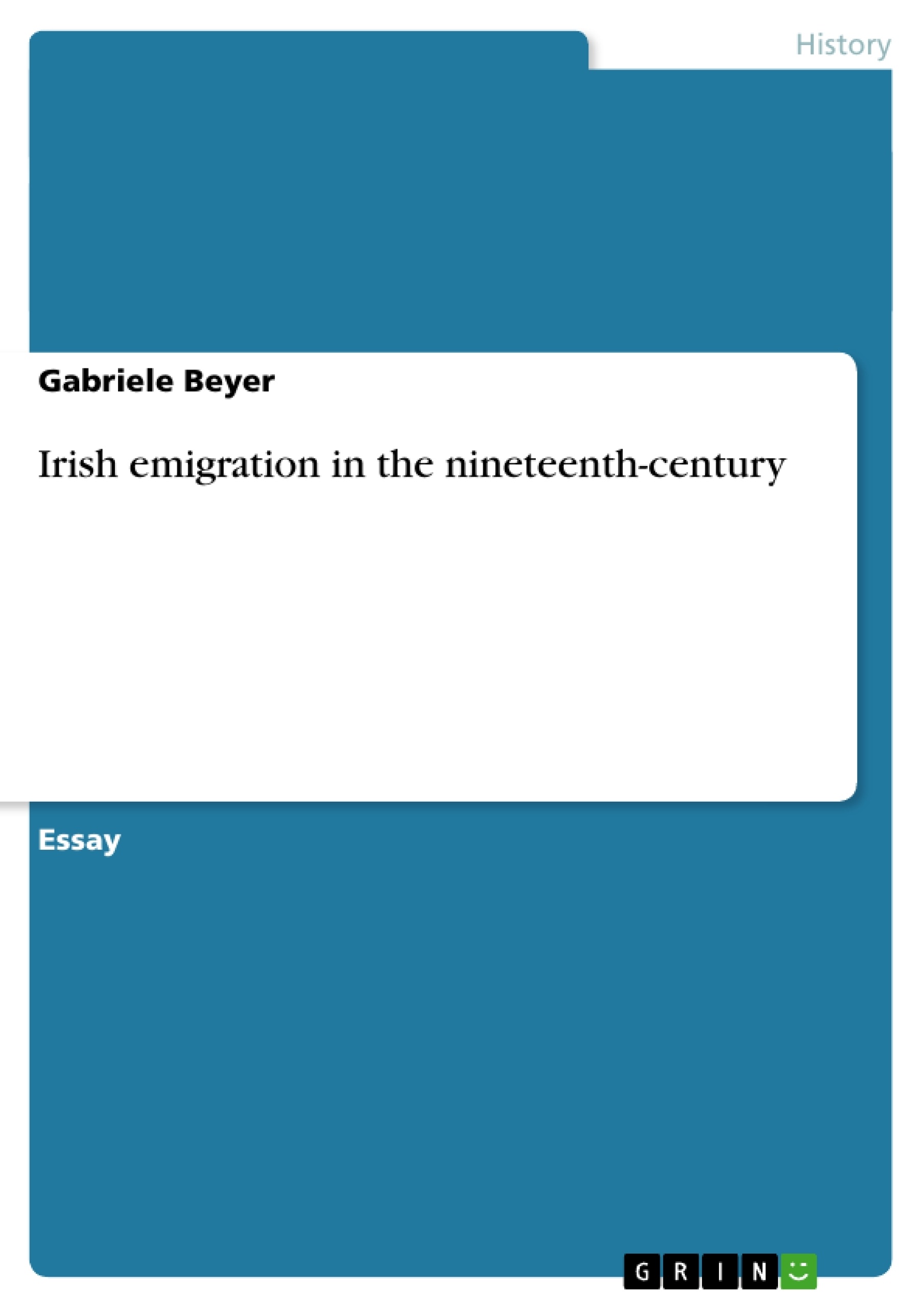In the following essay I want to start with some statistics and graphics – the demographical view to this topic. But there are even some other important perspectives.
So the next step will be, to take a look at the historical embedment and how the environment had an impact on the people’s behaviour.
Concluding I want to give an answer to the question: why was such a huge amount of people making the decision to emigrate in the 19th century of Ireland?
Introduction:
In the following essay I want to start with some statistics and graphics - the demographical view to this topic. But there are even some other important perspectives.
So the next step will be, to take a look at the historical embedment and how the environment had an impact on the people’s behaviour.
Concluding I want to give an answer to the question: why was such a huge amount of people making the decision to emigrate in the 19th century of Ireland?
Definition:
First of all I want to start with a generali definition of the item ‘emigration’.
“Emigration is the act of leaving one's country or region to settle in another. It is the same as immigration but from the perspective of the country of origin. Human movement before the establishment of political boundaries or within one state is termed migration. There are many reasons why people might choose to emigrate. Some are for reasons of religious, political or economic freedom or escape. Others have personal reasons such as marriage. Some people living in rich nations with cold climates choose to move to warmer climates when they retire.
[...] Motives to migrate can be either incentives attracting people away, known as pull factors, or circumstances encouraging a person to leave, known as push factors [...]”1
In summary the most important facts are, that it is a human movement and that there are quite different reason existing, why people choose to emigrate. On the one hand it might be a personal decision to improve once own life quality and on the other hand it is a kind of ‘no other option’. Situation in 1841: Pre-Famine Demographic and Poverty The graphic below gives an imagination about the immediate pre-famine period and the poverty in Ireland on the Eve ofthe Famine.
Abbildung in dieser Leseprobe nicht enthalten
The main fact we can grap out from this graphic is, that there is a close correlation between poverty and the types of agriculture.2
Demoqraphical Development:
As shown in this graphic famine radically re-drew the demographic map in Ireland in the 19th century. Emigration in this time often became the only option for several generations of the Irish poor. 3
Abbildung in dieser Leseprobe nicht enthalten
“In the earlydecades of the nineteenth century, the numbers migrating to Britain and America began to increase dramatically, with an estimated 1.500.000 leaving Irish shores between 1815 and 1845, driven by the population density.”4
Historical embedment - the Famine:5
Abbildung in dieser Leseprobe nicht enthalten6 7 8 9
In summary we can note, that:
“[...] it is generally held, that, of the pre-Famine population ofabout 8 million people, at least 1 million died and a further 1 million emigrated when the potato crop failed in three seasons out of four, thereby depriving about one third of the country of its staple diet.”10
Imports and Exports - economical backround:
Abbildung in dieser Leseprobe nicht enthalten11
I choose this graphic to underline the situation during the 19th century for the Irish people. As you can see, before the Famine started, exports were higher than imports. But this relationship changed in 1847 extremely. Nearly 900.000 tons were imported, less than 700.000 compared to the year before.
The government devised a twofold plan. Firstly, they would pass a temporary act to establish soup kitchens and second, they wanted to reliefwith the Poor Law system in a new commission.12
The imports included wheat and large quantities ofAmerican maize, but all in all not in a good quality.13
Emiqrationrates and places to qo:
“[...] between 1845 and 1870, approximately 3.000.000 people left Irish shores for the now traditional destinations of America, Canada, Australia and New Sealand, and swathe of Enqlish manufacturinq centres.”15
Interestinq places to qo were first of all America, Australia and Canada. A thousand of people also tried Britain. to find a place to live and work in Britain. The census in Britain shows around 400.000 Irish-born livinq in Britain.Britain.16
[...]
1 http ://en.wikipedia.org/wiki/Emigration
2 http://www.wesleyjohnston.com/users/ireland/past/famine/economics.html
3 http://www.wesleyjohnston.com/users/ireland/past/famine/demographics_pre.html
4 Hickey (1987)
5 Doherty and Hickey (1989)
6 Moody and Martin (1984)
7 Moody and Martin (1984)
8 Moody and Martin (1984)
9 Moody and Martin (1984)
10 Hickey (1987)
11 http://www.wesleyjohnston.com/users/ireland/past/famine/summer_1847.html
12 http://www.wesleyjohnston.com/users/ireland/past/famine/summer_1847.html
13 http://www.wesleyjohnston.com/users/ireland/past/famine/summer_1847.html
14 http://www.wesleyjohnston.com/users/ireland/past/famine/emigration.html
15 Hickey (1987)
16 http://www.wesleyjohnston.com/users/ireland/past/famine/emigration.html
- Arbeit zitieren
- MA Soziologie Gabriele Beyer (Autor:in), 2011, Irish emigration in the nineteenth-century, München, GRIN Verlag, https://www.grin.com/document/211089
-

-

-

-
Laden Sie Ihre eigenen Arbeiten hoch! Geld verdienen und iPhone X gewinnen. -

-
Laden Sie Ihre eigenen Arbeiten hoch! Geld verdienen und iPhone X gewinnen. -

-
Laden Sie Ihre eigenen Arbeiten hoch! Geld verdienen und iPhone X gewinnen. -

-
Laden Sie Ihre eigenen Arbeiten hoch! Geld verdienen und iPhone X gewinnen. -

-
Laden Sie Ihre eigenen Arbeiten hoch! Geld verdienen und iPhone X gewinnen. -

-
Laden Sie Ihre eigenen Arbeiten hoch! Geld verdienen und iPhone X gewinnen.

